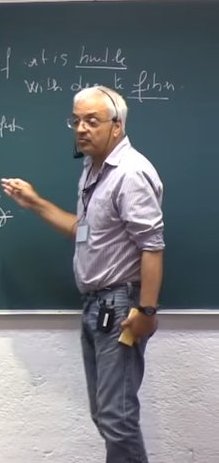Mikio Sato was a Japanese mathematician known for founding the fields of algebraic analysis, hyperfunctions, and holonomic quantum fields. He was a professor at the Research Institute for Mathematical Sciences in Kyoto.
In mathematics, the Bernstein–Sato polynomial is a polynomial related to differential operators, introduced independently by Joseph Bernstein (1971) and Mikio Sato and Takuro Shintani, Sato (1990). It is also known as the b-function, the b-polynomial, and the Bernstein polynomial, though it is not related to the Bernstein polynomials used in approximation theory. It has applications to singularity theory, monodromy theory, and quantum field theory.
In mathematics, hyperfunctions are generalizations of functions, as a 'jump' from one holomorphic function to another at a boundary, and can be thought of informally as distributions of infinite order. Hyperfunctions were introduced by Mikio Sato in 1958 in Japanese,, building upon earlier work by Laurent Schwartz, Grothendieck and others.
The mathematical term perverse sheaves refers to a certain abelian category associated to a topological space X, which may be a real or complex manifold, or a more general topologically stratified space, usually singular. This concept was introduced in the thesis of Zoghman Mebkhout, gaining more popularity after the (independent) work of Joseph Bernstein, Alexander Beilinson, and Pierre Deligne (1982) as a formalisation of the Riemann-Hilbert correspondence, which related the topology of singular spaces and the algebraic theory of differential equations. It was clear from the outset that perverse sheaves are fundamental mathematical objects at the crossroads of algebraic geometry, topology, analysis and differential equations. They also play an important role in number theory, algebra, and representation theory. The properties characterizing perverse sheaves already appeared in the 75's paper of Kashiwara on the constructibility of solutions of holonomic D-modules.

The Research Institute for Mathematical Sciences (RIMS) is a research institute attached to Kyoto University, hosting researchers in the mathematical sciences from all over Japan. RIMS was founded in April 1963.
In mathematics, a D-module is a module over a ring D of differential operators. The major interest of such D-modules is as an approach to the theory of linear partial differential equations. Since around 1970, D-module theory has been built up, mainly as a response to the ideas of Mikio Sato on algebraic analysis, and expanding on the work of Sato and Joseph Bernstein on the Bernstein–Sato polynomial.

Masaki Kashiwara is a Japanese mathematician. He was a student of Mikio Sato at the University of Tokyo. Kashiwara made leading contributions towards algebraic analysis, microlocal analysis, D-module theory, Hodge theory, sheaf theory and representation theory.
In mathematics, the term Riemann–Hilbert correspondence refers to the correspondence between regular singular flat connections on algebraic vector bundles and representations of the fundamental group, and more generally to one of several generalizations of this. The original setting appearing in Hilbert's twenty-first problem was for the Riemann sphere, where it was about the existence of systems of linear regular differential equations with prescribed monodromy representations. First the Riemann sphere may be replaced by an arbitrary Riemann surface and then, in higher dimensions, Riemann surfaces are replaced by complex manifolds of dimension > 1. There is a correspondence between certain systems of partial differential equations and possible monodromies of their solutions.
In mathematics, the FBI transform or Fourier–Bros–Iagolnitzer transform is a generalization of the Fourier transform developed by the French mathematical physicists Jacques Bros and Daniel Iagolnitzer in order to characterise the local analyticity of functions on Rn. The transform provides an alternative approach to analytic wave front sets of distributions, developed independently by the Japanese mathematicians Mikio Sato, Masaki Kashiwara and Takahiro Kawai in their approach to microlocal analysis. It can also be used to prove the analyticity of solutions of analytic elliptic partial differential equations as well as a version of the classical uniqueness theorem, strengthening the Cauchy–Kowalevski theorem, due to the Swedish mathematician Erik Albert Holmgren (1872–1943).
Algebraic analysis is an area of mathematics that deals with systems of linear partial differential equations by using sheaf theory and complex analysis to study properties and generalizations of functions such as hyperfunctions and microfunctions. Semantically, it is the application of algebraic operations on analytic quantities. As a research programme, it was started by the Japanese mathematician Mikio Sato in 1959. This can be seen as an algebraic geometrization of analysis. It derives its meaning from the fact that the differential operator is right-invertible in several function spaces.
Michio Jimbo is a Japanese mathematician working in mathematical physics and is a professor of mathematics at Rikkyo University. He is a grandson of the linguist Kaku Jimbo.

Zoghman Mebkhout is a French-Algerian mathematician. He is known for his work in algebraic analysis, geometry and representation theory, more precisely on the theory of D-modules.
Victor Ivrii, is a Russian, Canadian mathematician who specializes in analysis, microlocal analysis, spectral theory and partial differential equations. He is a professor at the University of Toronto Department of Mathematics.
J. (Jean) François Trèves is a French mathematician, specializing in partial differential equations.
Michael Eugene Taylor is an American mathematician, working in partial differential equations.
In the mathematical field of algebraic topology, the orientation sheaf on a manifold X of dimension n is a locally constant sheaf oX on X such that the stalk of oX at a point x is

Jean-Michel Bony is a French mathematician, specializing in mathematical analysis. He is known for his work on microlocal analysis and pseudodifferential operators.

András Vasy is an American, Hungarian mathematician working in the areas of partial differential equations, microlocal analysis, scattering theory, and inverse problems. He is currently a professor of mathematics at Stanford University.
In algebraic topology, a locally constant sheaf on a topological space X is a sheaf on X such that for each x in X, there is an open neighborhood U of x such that the restriction is a constant sheaf on U. It is also called a local system. When X is a stratified space, a constructible sheaf is roughly a sheaf that is locally constant on each member of the stratification.

Tetsuji Miwa is a Japanese mathematician, specializing in mathematical physics.






